Dissociative identity disorder: causes, symptoms, and treatments
Table of content
- What is dissociative identity disorder?
- How common is dissociative identity disorder?
- What are the causes of dissociative identity disorder?
- What are the symptoms of dissociative identity disorder?
- What effects does dissociative identity disorder have on a person’s life?
- What are the risk factors for dissociative identity disorder?
- What are the treatments available for dissociative identity disorder?
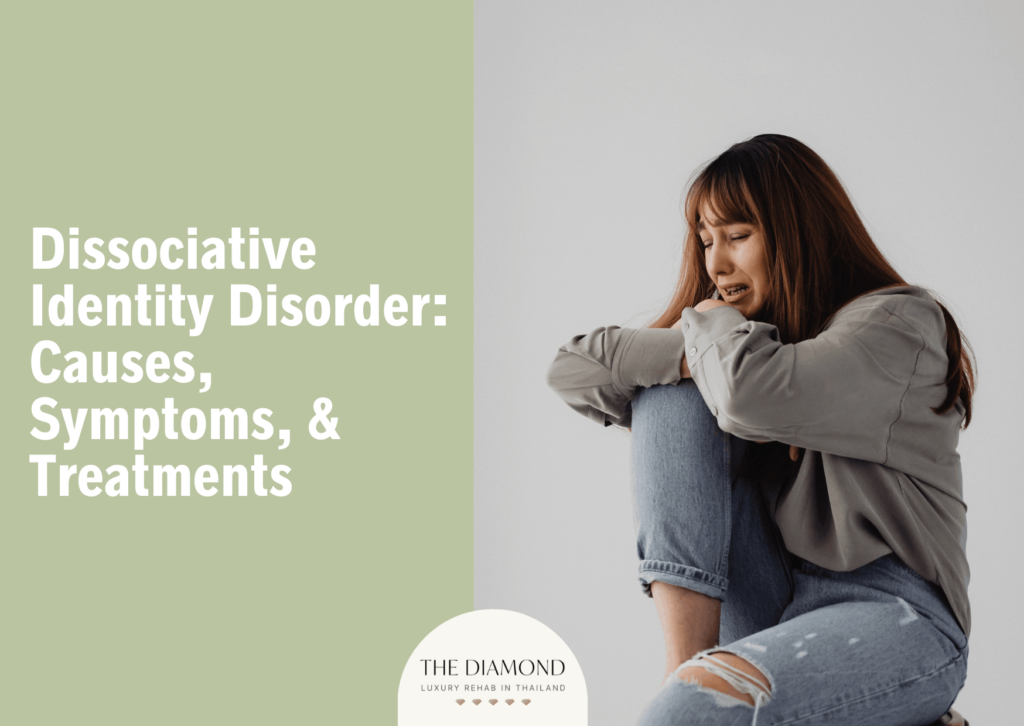
Dissociative identity disorder is a type of disorder wherein a person has multiple personalities. They switch from one identity to another. Each identity has its name and other characteristic traits. A person changes identities unconsciously. It is not the same as schizophrenia, where people have an impaired perception of reality and hear or see things that aren’t there.
The main cause of dissociative identity disorder is long-term trauma. Children affected by trauma in the form of sexual, emotional, verbal, or any other kind of abuse dissociate themselves as a way to cope with their scary experiences.
The tendency to dissociate becomes their main coping mechanism. They are more likely to create separate identities. War, kidnapping and torture, and natural disasters lead to dissociative identity disorder as well. Patients with this condition additionally tend to have abnormalities in certain brain structures.
Symptoms of dissociative identity disorder include anxiety, delusions, depression, disorientation, drug or alcohol abuse, memory loss, and suicidal thoughts or self-harm.
Treatments for dissociative identity disorder revolve around psychotherapy, mainly cognitive-behavioral therapy. Doctors occasionally prescribe medications to manage the underlying symptoms. In certain cases, hypnosis is used in combination with other approaches.
What is dissociative identity disorder?
Dissociative identity disorder (DID), formerly known as multiple personality disorder or split personality disorder, is a serious disorder characterized by switching or alternating between multiple identities.
These separate identities control a person’s behavior at different times. Each identity, i.e., alters, that a person with DID develops has its own personal history, name, unique traits, likes, and dislikes. It is possible for one person to have up to 100 alters.
The disorder tends to start in children or adolescents. Less than 20% of people with DID start experiencing dissociative episodes after the age of 20. One personality state is dominant, and it’s capable of functioning normally in daily life.
However, non-dominant personality states act like intruders to this dominant personality state. This is called dissociative intrusion. The dissociative intrusions are classified as affective, cognitive, motor, perceptual, or behavioral. They interfere with normal functioning. Certain people are not aware of these identity changes, whereas others know they have them.
Periods of dissociation are short and last anywhere from a few minutes to a few hours or days. However, in certain cases, they tend to be longer and last for weeks or months.
The Diagnostic and Statistical Manual of Mental Disorders, fifth edition (DSM-5) by the American Psychiatric Association classifies DID among dissociative disorders. Other types of dissociative disorder include dissociative amnesia and depersonalization-derealization disorder, as per a 2023 article titled, “Dissociative disorders” from Mayo Clinic.
The term multiple or split personality disorder was used until 1994 when DSM-4 was published. From that point on, dissociative identity disorder is the official term for this condition. The name was changed to reflect a better understanding of DID. The goal was to point out that DID is characterized by the splintering or fragmentation of identity rather than by the growth or proliferation of separate personalities.
The first documented account of a person with multiple personalities dates back to 1791 when a 20-year-old German woman started speaking perfect French. She spoke German, but with a French accent. The patient remembered everything she did as a French woman, but wasn’t able to remember those details when she was speaking German.
One of the first patients to be diagnosed with this disorder was Louis Vivet in 1885, even though the term multiple personalities wasn’t in use at that point. A year later, in 1886, psychological literature featured the term “multiple personalities” for the first time in direct reference to Louis Vivet.
The case of Vivet is one of the earliest examples of the severity of this disorder. Born to a French prostitute, Vivet was beaten and neglected during his childhood. At the young age of only eight years, Vivet turned to crime and was sent to the house of corrections where he lived until he turned 18.
When he was 17, Louis Vivet had an accident that left him paralyzed from the waist down. He lived in an asylum and started working as a tailor for one and a half years, but suddenly he regained the use of his legs and started working again.
When people from the asylum questioned him over his extraordinary recovery, Vivet responded with confusion. He didn’t recognize the hospital staff at all. Then, he accused them of trying to imprison him.
It was widely believed Louis Vivet had 10 different personalities, but newer records state there were only two of them.
The disorder itself was first discovered in the late 1880s, as mentioned above, by Dr. Jean Martin Charcot, a chief physician at Salpetriere Hospital in Paris. Initially, it was called hysteron-epilepsy because the disorder was believed to combine two already known conditions: hysteria and epilepsy.
Even though the disorder was described in the 19th century and there were certain cases of people with multiple personalities before that, DID has been around a lot longer than that. The biggest problem here is that symptoms associated with dissociative identity disorder were attributed to other issues such as possession, schizophrenia, and hysteria.
For example, in 1584 document La Possession by Jeanne Fery provided a detailed account of her exorcism. The exorcists added certain information. Jeanne had multiple personalities, each with its own identity and unique characteristics.
How common is dissociative identity disorder?
Dissociative identity disorder is quite rare, as it is estimated that approximately 1.5% of the world’s population is diagnosed with this condition, according to a continuing education activity by Paroma Mitra and Ankit Jain last updated in May 2023 from StatPearls.
On the other hand, a paper by Brand et al., published in the July 2016 issue of the Harvard Review of Psychiatry reported that research employing strict protocols, such as sequential clinical admissions and organized clinical interviews, discovered DID in 0.4% — 6.0% of clinical samples.
The number of people with DID is possibly higher i.e. the disorder, meaning the condition is likely more prevalent than initially thought. The disorder is often misdiagnosed and requires multiple assessments for accurate diagnosis. As a result, it’s impossible to determine how many people in the world actually have dissociative identity disorder.
What are the causes of dissociative identity disorder?
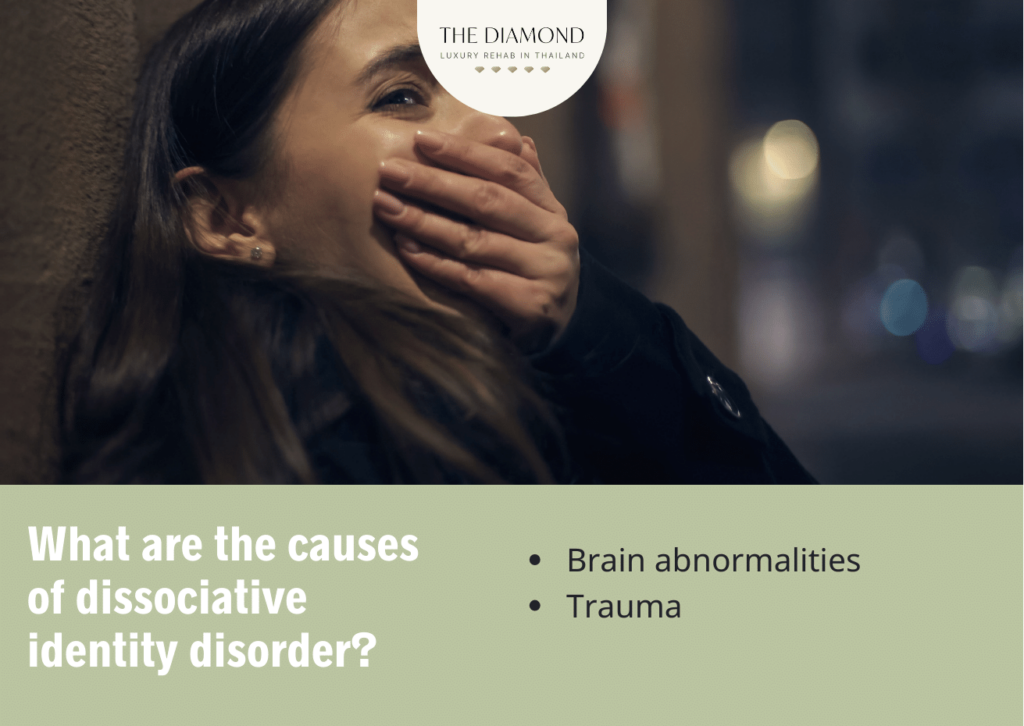
The causes of dissociative identity disorder are multifaceted and often involve a combination of different factors. The causes of dissociative identity disorder are listed below.
- Trauma: Trauma is known to be the main cause of DID. Patients usually develop this disorder as a way to cope with the long-term trauma they experienced. In most cases, DID forms in childhood when personal identity is still forming. Children are more capable than adults to step outside of themselves and observe trauma like it’s happening to another person. Children who dissociate to cope or survive traumatic experiences continue using this coping mechanism to react to other stressful situations throughout their lives. In other words, a person subconsciously creates other personalities, they don’t do it on purpose. However, without these personalities, they won’t be able to cope with trauma.
- Brain abnormalities: While the primary cause of dissociative identity disorder is trauma, it’s important to mention patients with this serious condition tend to have differences in brain structure. Individuals diagnosed with DID exhibit reduced cortical and subcortical volumes in key brain regions, including the amygdala, parietal structures responsible for perception and self-awareness, frontal structures involved in movement execution and fear learning, and hippocampus. Patients with DID additionally show enlarged white matter tracts, which facilitate the transmission of information between the precuneus, basal ganglia, and somatosensory association areas. There appears to be an association between these neuroanatomical alterations and prevalent symptoms of DID, including host dissociation, neurotic defense mechanisms, and general brain activation/circuitry recruitment, according to a 2020 paper by Blihar et al., published in the European Journal of Trauma & Dissociation.
What are the symptoms of dissociative identity disorder?
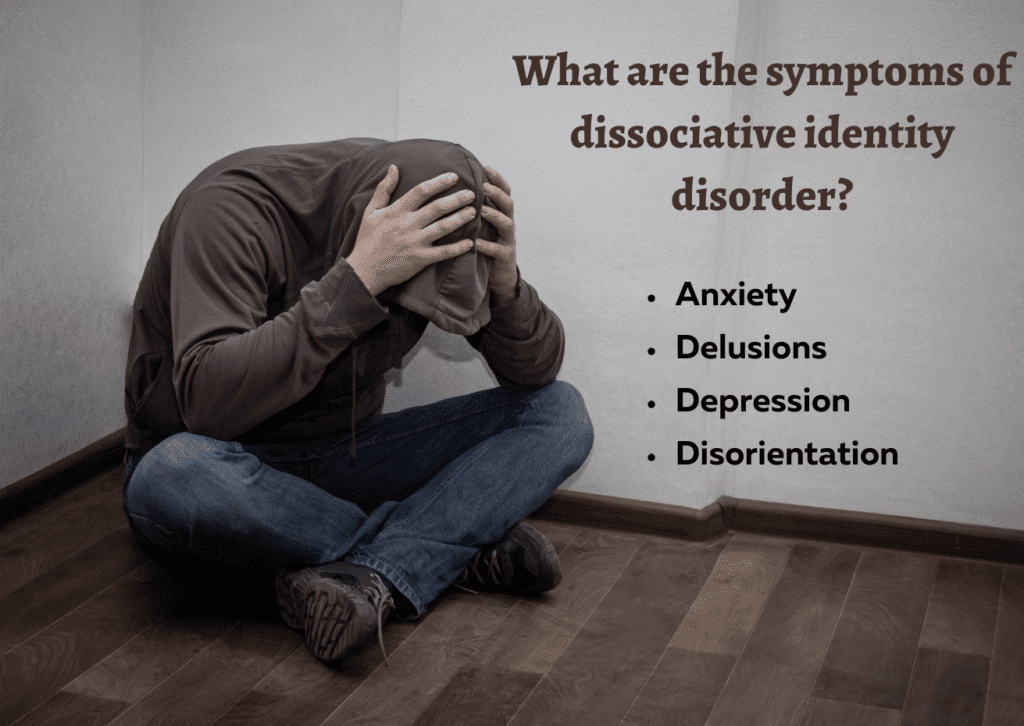
The symptoms of dissociative identity disorder encompass a wide range of experiences and behaviors that are indicative of having several identity states. The symptoms of dissociative identity disorder are listed below.
- Anxiety
- Delusions
- Depression
- Disorientation
- Drug or alcohol abuse
- Memory loss
- Suicidal thoughts or self-harm
1. Anxiety

Anxiety is a type of mental health condition indicated by feelings of unease, worry, and fear that range in intensity from mild to severe. The exact cause of anxiety is relatively unknown, but various factors play a role.
These include traumatic experiences, genetics, various health conditions, stress, drugs, and alcohol. The main symptoms of anxiety include intense nervousness, impending doom, hyperventilation, rapid heart rate, sweating, and trembling.
A wide range of factors contribute to symptoms of anxiety, and dissociative identity disorder isn’t an exception. While it doesn’t seem so at first, anxiety and dissociative identity disorder have one major thing in common.
Trauma is a major catapult for both conditions. People with DID develop several identities as a way to handle traumatic experiences they endured. At the same time, people who have experienced trauma internalize the event and develop subsequent negative thoughts about themselves and the world.
Both anxiety and dissociative identity disorder are the result of a person’s mind trying to protect them. For that reason, these conditions contribute to one another. People with childhood traumas are more likely to develop symptoms of anxiety and even post-traumatic stress disorder (PTSD). Since traumatic experiences trouble a person with DID, it explains why patients develop anxiety and panic disorder as well.
As DID has a major impact on a person’s life, they develop anxiety due to other symptoms of this disorder. For example, problems with memory make a person feel anxious and insecure. Certain people develop anxiety because they are afraid of personality change.
This is particularly the case for persons who are aware of their different identities. The fear and nervousness associated with alternating identities worsen both anxiety and dissociative identity disorder at the same time.
In a 2018 case study by Rehan et al., published in Cureus, a woman with dissociative identity disorder experienced anxiety during a change in personality states, which happen involuntarily at any moment, though it usually happens under pressure and when abusing drugs.
2. Delusions
Delusions are beliefs that are clearly false and indicate the person’s content of thought is impaired. In other words, delusion is an unshakeable belief in something that isn’t true. It is not the same thing as hallucination, which refers to seeing or hearing something that isn’t there.
An individual with delusions firmly believes in something even though they have no evidence to support that. Delusion isn’t a standalone mental health condition but rather a symptom of a serious disorder. It is associated with schizophrenia, delusional disorder, and other conditions such as dissociative identity disorder.
However, it is worth noting that the 12th chapter of the book titled, “Psychosis, Trauma, and Dissociation: Evolving Perspectives on Severe Psychopathology” published in 2018 by John Wiley & Sons Ltd., explained how when a patient has DID, their internal experiences of having several identities or personalities within themselves give rise to what appear to be delusions. These ideas reflect the patients’ subjective experiences of their dissociative identities rather than being the product of a primary thought disorder, as is the case with schizophrenia..
In addition, a 2013 study by Andreas Laddis and Paul F. Dell published in the Journal of Trauma & Dissociation reported that psychosis is common in both schizophrenia and DID.
It is not entirely clear why DID causes delusions. However, it is important to mention that a multitude of causes lead to delusions, including sleep disturbances, extreme stress, brain injury, drug addiction, and alcoholism.
When a person is under a lot of stress, they tend to dissociate. At the same time, a lot of stress causes delusions. In certain situations, delusions in patients with dissociative identity disorder occur due to substance abuse. A 2021 review by Fiorentini et al., published in Frontiers in Psychiatry confirmed that psychosis is common among persons with addiction.
The rise of delusions in patients with dissociative identity disorder is linked to memory deficits. Delusional thoughts are linked to lapses in memory and poor insight. A person’s inability to remember accurate information paves the way to nourishing inaccurate and irrational beliefs.
A study by Martinez et al., published in the December 2020 issue of the Journal of Psychiatric Research found that participants with DID exhibited a higher degree of mistrust, delusional beliefs, and associated traits compared to their counterparts with schizophrenia. The presence of depersonalization/derealization symptoms in the DID group was found to be a significant predictor of mistrust beliefs.
3. Depression

Depression is a serious mental health disorder characterized by feelings of sadness, loss of interest, and other symptoms that affect how a person thinks or feels. Potential causes of depression include changes in brain chemistry, biological differences, hormones, genetics, and others. Also, people with dissociative identity disorder frequently have depression.
A study from Social Work in Health Care reported that over 80% of patients with DID have a history of a major depressive episode. The same study also showed depression affects patients with DID differently than persons who don’t have this disorder.
Compared to non-dissociative participants, DID patients had higher rates of somatization symptoms and were more likely to report some interpersonal-related symptoms, such as unstable relations and fear of abandonment. Also, persons with DID experienced more trauma-related symptoms such as flashbacks and were also more likely to receive an unsatisfactory level of help from family and have a history of childhood physical abuse.
Memories of trauma can induce negative feelings and contribute to depression in patients with DID. That said, two conditions could go hand in hand. Many patients with DID have periods of severe depression, particularly around the anniversary of their traumatic experience, which is when they also tend to dissociate more. At the same time, they explain their general effect is just melancholic.
The problem with DID and depression is that they can worsen one another. The treatment of DID becomes more complicated when a patient develops depression. Sometimes conventional treatments for depression don’t work on people who also have dissociative identity disorder. Depression in DID is rooted in trauma, which could explain why this symptom happens. It also explains why people dissociate more when they’re stressed out regarding something related to the traumatic experience they survived. A good example is an anniversary.
When it comes to depression in DID, it affects the whole person, not just one alter. That said, patients with dissociative identity disorder may experience a sense of separation and unawareness of emotions between different identities. For that reason, they may feel like one alter has depression while the other doesn’t.
Traumatic experiences can lead to depression, which is one thing in common it has with DID. This could be yet another link between DID and depression as its symptom.
4. Disorientation
Disorientation is an altered mental state indicated by the inability to correctly acknowledge the current time, place, personal identity, and one’s role. It is not a specific disease, but it can occur as a symptom of a more serious mental health condition. Common causes of disorientation include delirium and dementia, drugs, amnesia, epilepsy, and many other illnesses. Dissociative identity disorder can also cause disorientation.
It is not entirely clear how DID causes disorientation. One explanation is that dissociative identity disorder includes alters i.e. parts that aren’t accepted or integrated into a single “self”. The lack of integration leads to confusion and disorientation.
Additionally, people who come out of a dissociative episode may feel disoriented. Since they have no control of the other identity, non-dominant alter, the ending of this episode may be particularly difficult. A person may wonder where they are and how they ended up somewhere and show other signs of disorientation.
The presence of disorientation in people with dissociative identity disorder is also linked to other symptoms. For example, anxiety can also contribute to disorientation during or after an anxiety attack. Gaps in memory created by DID could also further add to disorientation. The same goes for substance abuse and, especially, the withdrawal process.
5. Drug or alcohol abuse

Drug and alcohol abuse occur due to a number of factors. Some people have a genetic predisposition for substance abuse. Others use drugs or alcohol to cope with trauma or peer pressure, other mental health disorders, and dysfunctional family dynamics. Many people with dissociative disorders, such as DID, turn to drugs and alcohol to escape from their trauma. This usually happens in cases when dissociating still isn’t enough for them to cope with the trauma they endured.
At that point, drugs and other substances with addictive potential may seem like a good way to find relief. However, they do more harm than good. With prolonged use, a patient with DID also develops substance use disorder. Plus, substance abuse can intensify symptoms of dissociative identity disorder i.e. worsen a patient’s mental state. Drug abuse can make dissociative people feel even more disconnected from their experiences. It can also make the gap between intrusive emotions and dissociative states even more pronounced.
Symptoms of DID occur as a way to avoid unpleasant memories and emotions associated with trauma, but substance abuse can increase the frequency where the aversive states pass by dissociative defenses. It forms a vicious cycle where dissociative symptoms aggravate, and a patient increases substance abuse to cope.
6. Memory loss
Memory loss represents unusual forgetfulness. A person may not be able to recall new events, memories from the past, or both. Sometimes memory loss is short-term, but in other cases, it persists. Causes of memory loss are numerous and include aging, medical conditions, dementia such as Alzheimer’s disease, emotional problems, and many others. Patients with dissociative identity disorder tend to struggle with memory loss, too. They may struggle to remember information about themselves.
In this case, memory loss happens because a person with DID blocks out certain events. These events are usually linked to trauma or stress. For that reason, patients with dissociative identity disorder can’t remember some important personal information.
Clinical Psychology Review published a paper that explained that amnesic barriers between different alters are usually impervious to explicit stimuli and conceptually driven implicit stimuli. In patients with DID, autobiographical memory deficits are also evident. The term autobiographical memory refers to the memory of personal history. The paper also reports that pseudomemories (fake memories) are uncommon but a real phenomenon in patients with dissociative identity disorder. Some patients may also have deficits in working memory.
Memory loss in persons with DID goes beyond personal history and certain events. People can also experience memory gaps about everyday things and events in their life. Memory gaps are more pronounced in times of frequent dissociative episodes. Alternating between different identities leaves a lot of space for a person to forget things from their day-to-day life.
It’s also useful to keep in mind other symptoms of DID can exacerbate memory loss. Anxiety, depression, and substance abuse are all associated with memory loss and may further worsen this symptom in patients with DID.
7. Suicidal thoughts or self-harm
Suicidal thoughts and self-harm are always symptoms of a serious underlying problem. For example, they are often associated with depression. Other mental health disorders can also lead to suicidal ideation and self-harm tendencies. Dissociative identity disorder is among them. In fact, suicide is one of the most observed symptoms of dissociative identity disorder. Suicide rates among patients with DID are high and go up to 70% to 72%.
People with this disorder tend to feel hopeless and display signs of anhedonia (inability to feel pleasure). These are also the hallmark symptoms of depression. They, together with dissociation, represent some of the most significant psychopathological symptoms that often lead to suicidal thoughts and tendencies. They also contribute to self-harm.
According to a paper from the European Journal of Psychotraumatology reasons behind self-injury for people with DID include trauma-related cues, emotion dysregulation, stressors, psychiatric and physical health symptoms, ineffective coping attempts, and dissociative experiences. Some people, however, are unaware of what leads them to harm themselves.
Suicidal ideation in patients with DID is a more complicated problem than people think. Just because one identity is suicidal, it doesn’t mean others are too. For that reason, it is entirely possible for suicidal thoughts and tendencies to occur without the knowledge of the dominant identity.
What effects does dissociative identity disorder have on a person’s life?
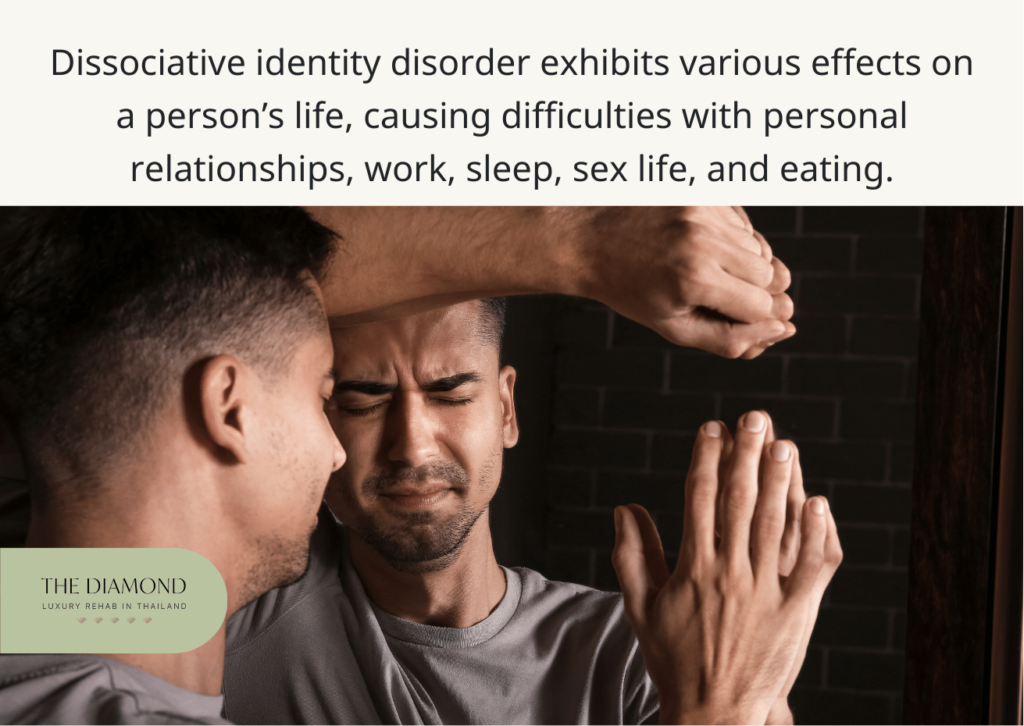
Dissociative identity disorder exhibits various effects on a person’s life, causing difficulties with personal relationships, work, sleep, sex life, and eating. It’s important to keep in mind that for people with DID their reality of selfhood is significantly different from what we experience. At different points, patients with dissociative identity disorder interact with the world around them through more than one identity. Their “alters” take turn living their life, which is why the effects of this disorder are strong. This is especially when DID is unmanaged or inadequately treated.
Dissociative identity disorder can create major difficulties in personal relationships and at work. For people with DID, maintaining relationships is complicated, especially when their alters have different temperaments to which other people can’t adjust easily. While some people with DID go on to have successful relationships, for many individuals, they can be quite stifling. As painful memories arise, a patient with DID dissociates unconsciously. Later they can feel guilty knowing the other person feels hurt or trapped by their dissociation.
The disorder can affect a person’s sex life, too. For example, patients may experience difficulties with lubrication, arousal, and achieving or maintaining erections. Their sex drive may also suffer. Speaking of this subject, dissociation during sex increases vulnerability to sexual revictimization and risky sexual behaviors, according to a paper from the Journal of Trauma & Dissociation.
Dissociative identity disorder increases the risk of eating disorders, sleep disorders, and non-epileptic seizures. Individuals with DID are more likely to have nightmares, insomnia, and sleepwalking. They are more susceptible to developing substance use disorders and mental health disorders. The most severe effect of DID is suicide.
What are the risk factors for dissociative identity disorder?
Risk factors for dissociative identity disorder are different types of traumatic experiences listed below.
- Long-term physical abuse
- Long-term sexual abuse
- Long-term emotional abuse
- Frightening or highly unpredictable home environment
- War
- Natural disasters
- Torture
- Kidnapping
- Traumatic, early-life medical procedures
How is dissociative identity disorder diagnosed?
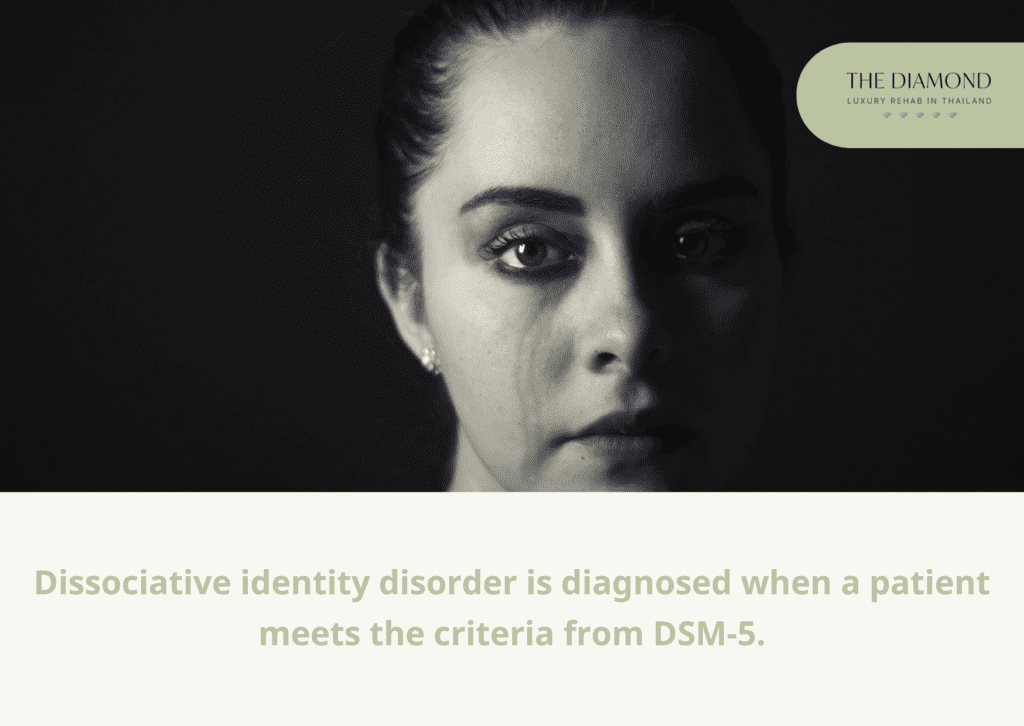
Dissociative identity disorder is diagnosed when a patient meets the criteria from DSM-5. Before that, a thorough evaluation that includes a physical and psychiatric exam is necessary.
The main purpose of the physical exam is to determine (and eliminate) physical conditions that may cause symptoms such as a sense of unreality and memory loss. These conditions are head injury, sleep deprivation, intoxication, and some brain diseases.
Once the physical conditions have been ruled out, a doctor refers a patient to a psychiatrist for a psychiatric evaluation. During the psychiatric evaluation, the patient discusses their symptoms and answers questions regarding their feelings, thoughts, and behaviors. Sometimes a psychiatrist will ask the patient for permission to talk to their family members to gather more information.
Then, mental health professional compares a patient’s symptoms to the criteria for diagnosis of dissociative disorders in DSM—5. They will diagnose DID if a patient meets criteria such as having two or more distinct personalities and recurrent gaps in memory for everyday events.
Also, symptoms mustn’t result from intoxication or other physical causes and aren’t a part of broadly accepted religious or cultural practice. Finally, the symptoms are severe enough to cause significant distress and have a major impact on a person’s quality of life.
What are the treatments available for dissociative identity disorder?
Treatments available for dissociative identity disorder are listed below.
- Medications: there are no medications that are formulated specifically for the treatment of dissociative identity disorder, but a doctor may prescribe some drugs to manage various mental health symptoms. In most cases, these drugs are antipsychotic medications, anti-anxiety medications, and antidepressants.
- Psychotherapy: the main treatment for DID and other dissociative disorders. It involves talking with a mental health professional about mental health. The main goal is to help patients learn to cope with their disorder and understand its cause. Various types of talk therapy can aid the management of DID, including:
- Cognitive-behavioral therapy (CBT): helps patients with DID focus on identifying unhealthy or negative thought patterns and behaviors, and on replacing them with more positive alternatives. Additionally, CBT helps persons with DID process past traumas and learn to cope with other mental health problems that co-occur with DID, such as depression. A study from the Psychiatric Clinics of North America confirms that CBT is an effective treatment modality for decreasing symptoms and improving functional outcomes among patients with multiple personality disorders i.e. DID. It emphasizes the link between implicit, automatic thoughts and their underlying schemas, which are impaired in patients with this disorder. Also, CBT focuses on practical goals, skills training, and homework assignments that help patients practice skills in everyday life.
- Dialectical-behavioral therapy (DBT): is used in the treatment of numerous psychological disorders such as borderline personality disorder, eating disorders, and others. This type of therapy is mainly suitable for mental health problems that cause intense emotions and impulsive behaviors. It helps patients acknowledge negative thought patterns and challenge them to reduce their intensity. With DBT, patients with DID can regain control and decrease harmful behaviors. Exercises that are a part of DBT can reduce dissociation by allowing a person to be present in the moment.
- Eye movement desensitization and reprocessing (EMDR): a type of psychotherapy that enables people to heal from emotional distress and other symptoms resulting from disturbing or traumatic life experiences. It focuses directly on memory and aims to change the way that memory is stored in the brain. When used in combination with other approaches, EMDR can be helpful for patients with dissociative identity disorder. However, to use EMDR effectively it is necessary to adapt the framework of the therapy to address severe symptoms of DID.
- Hypnosis: some healthcare professionals may recommend hypnosis in combination with psychotherapy. It works as guided meditation and helps patients recover suppressed memories.

